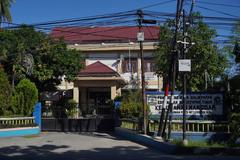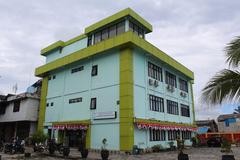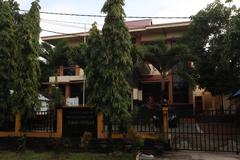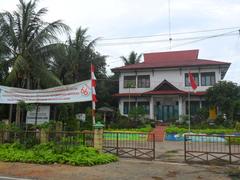
Comprehensive Guide to Visiting Bukit Kebo Km 8, Balikpapan, Indonesia
Date: 20/07/2024
Introduction
Bukit Kebo Km 8, situated in Balikpapan, Indonesia, is a destination brimming with historical, cultural, and natural allure. This guide delves into the region’s rich history, spanning from its early settlement by the indigenous Dayak people to its strategic importance during World War II. The area holds a unique position in the hearts of locals and visitors alike, thanks to its blend of cultural significance and natural beauty. Whether you are a history enthusiast, nature lover, or cultural explorer, Bukit Kebo Km 8 offers a multifaceted experience. This guide aims to provide detailed information about visiting hours, ticket prices, cultural landmarks, and nearby attractions, ensuring a well-rounded and enriching visit. For more detailed and updated information, you can visit the Balikpapan City Government website and the Indonesian Ministry of Tourism website.
Table of Contents
- Introduction
- Early Settlement and Indigenous Influence
- Colonial Era and Economic Development
- World War II and Japanese Occupation
- Post-Independence Era and Modern Development
- Visiting Bukit Kebo Km 8 - Hours and Ticket Information
- Cultural and Environmental Significance
- Nearby Attractions and Travel Tips
- Preservation Efforts and Future Prospects
- Frequently Asked Questions (FAQ)
- Conclusion
Early Settlement and Indigenous Influence
Bukit Kebo Km 8, located in Balikpapan, Indonesia, has a rich historical tapestry that dates back to the early settlement periods. The region was originally inhabited by indigenous tribes, primarily the Dayak people, who have lived in the Kalimantan region for centuries. The Dayak tribes are known for their unique culture, traditional longhouses, and intricate tattoos, which are a significant part of their identity. The area around Bukit Kebo was used for hunting and gathering, and the Dayak people practiced shifting cultivation, which involved clearing small patches of forest for agriculture.
Colonial Era and Economic Development
The history of Bukit Kebo Km 8 took a significant turn during the colonial era. In the late 19th and early 20th centuries, the Dutch East Indies government began to explore and exploit the natural resources of Kalimantan, including Balikpapan. The discovery of oil in Balikpapan in 1897 by the Dutch company Koninklijke Nederlandsche Petroleum Maatschappij (now part of Royal Dutch Shell) marked the beginning of rapid economic development in the region. Bukit Kebo, being in close proximity to Balikpapan, saw an influx of workers and settlers who came to work in the burgeoning oil industry.
World War II and Japanese Occupation
During World War II, Bukit Kebo Km 8, like much of Balikpapan, was significantly impacted by the Japanese occupation of Indonesia. In 1942, Japanese forces invaded and occupied Balikpapan, recognizing its strategic importance due to its oil reserves. The occupation led to the construction of military installations and fortifications in and around Bukit Kebo. The local population endured harsh conditions, and many were forced into labor to support the Japanese war effort. The area also witnessed several battles between Japanese and Allied forces, particularly during the Battle of Balikpapan in 1945, which was one of the last major battles of the Pacific War.
Post-Independence Era and Modern Development
Following Indonesia’s independence in 1945, Bukit Kebo Km 8 transitioned into a period of reconstruction and modernization. The Indonesian government, recognizing the strategic importance of Balikpapan’s oil industry, invested in infrastructure development in the region. Bukit Kebo became a residential and commercial area, with new housing developments, schools, and markets emerging to accommodate the growing population.
Visiting Bukit Kebo Km 8 - Hours and Ticket Information
Visitors to Bukit Kebo Km 8 can explore the region’s historical and cultural landmarks from 9 AM to 5 PM daily. Tickets can be purchased on-site or online through the Balikpapan City Government website. Admission fees are modest, making it an affordable destination for both locals and tourists.
Cultural and Environmental Significance
Bukit Kebo Km 8 is not only significant for its historical and economic contributions but also for its cultural and environmental importance. The area is home to several cultural landmarks, including traditional Dayak longhouses and community centers that celebrate the indigenous heritage of the region. Additionally, Bukit Kebo is known for its lush greenery and natural beauty, with several parks and nature reserves that attract tourists and nature enthusiasts.
Nearby Attractions and Travel Tips
While visiting Bukit Kebo Km 8, consider exploring other nearby attractions such as the Balikpapan Botanical Garden and Manggar Beach. Travel tips include carrying sufficient water, wearing comfortable shoes for walking, and respecting local customs and traditions.
Preservation Efforts and Future Prospects
In recent years, there has been a growing awareness of the need to preserve the historical and cultural heritage of Bukit Kebo Km 8. Local government and community organizations have initiated efforts to document and protect historical sites, promote cultural tourism, and ensure sustainable development in the area. These efforts aim to balance economic growth with the preservation of the unique cultural and environmental assets of Bukit Kebo.
Frequently Asked Questions (FAQ)
Q: What are the visiting hours for Bukit Kebo Km 8? A: Bukit Kebo Km 8 is open daily from 9 AM to 5 PM.
Q: How much are the tickets to visit Bukit Kebo Km 8? A: Tickets can be purchased on-site or online, with modest admission fees.
Q: Are there any nearby attractions? A: Yes, nearby attractions include the Balikpapan Botanical Garden and Manggar Beach.
For more detailed information on the historical background of Bukit Kebo Km 8, you can visit the Balikpapan City Government website and the Indonesian Ministry of Tourism website.
Conclusion
Visiting Bukit Kebo Km 8 in Balikpapan offers a unique opportunity to explore a site rich in history, culture, and natural beauty. From its early days as a settlement of the Dayak people to its significant role during the colonial and World War II eras, Bukit Kebo Km 8 provides a fascinating glimpse into Indonesia’s past. Modern visitors can enjoy its lush greenery, cultural landmarks, and accessible trails, making it a perfect destination for a diverse range of interests. Efforts to preserve its historical and cultural heritage ensure that Bukit Kebo Km 8 remains a cherished site for future generations. For more updates and information, consider downloading the Audiala app or following related social media channels.



